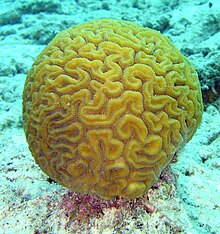Faviidae
| Brain coral | |
|---|---|
 |
|
| Diploria labyrinthiformis (grooved brain coral) | |
| Scientific classification | |
| Kingdom: | Animalia |
| Phylum: | Cnidaria |
| Class: | Anthozoa |
| Order: | Scleractinia |
| Family: |
Mussidae Ortmann, 1890 |
| Genera | |
|
Agathiphyllia |
|
Agathiphyllia
Antiguastrea
Barabattoia
Caulastraea
Colpophyllia
Cyphastrea
Diploastrea
Diploria
Echinopora
Favia
Favites
Goniastrea
Hadrophyllia
Leptoria
Manicina
Montastraea
Oulophyllia
Platygyra
Thysanus
Brain coral is a common name given to corals in the family Mussidae, so called due to their generally spheroid shape and grooved surface which resembles a brain. Each head of coral is formed by a colony of genetically identical polyps which secrete a hard skeleton of calcium carbonate; this makes them important coral reef builders like other stony corals in the order Scleractinia.
Brain corals are found in shallow warm-water coral reefs in all the world's oceans. They are part of the phylum Cnidaria, in a class called Anthozoa or "flower animals". The lifespan of the largest brain corals is 900 years. Colonies can grow as large as 1.8 m (6 ft) or more in height.
...
Wikipedia
